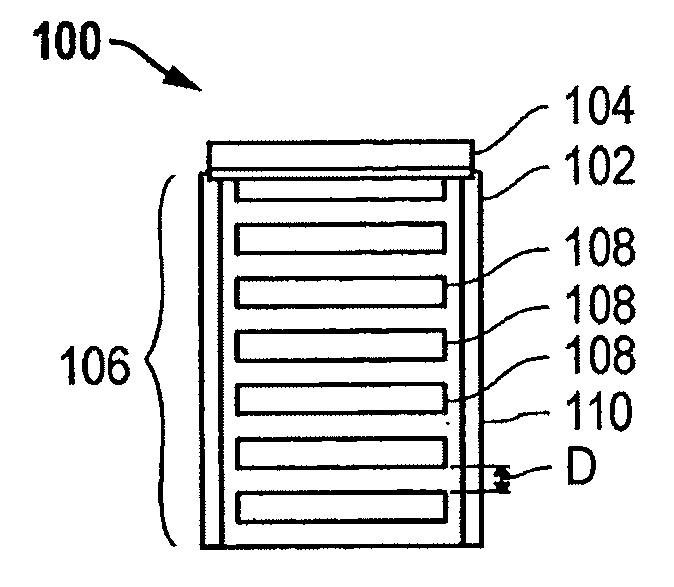Storage Device for Sorption and Desorption of Molecular gas contained by Storage Sites of Nano-filament Laded Reticulated Aerogel
a technology of nano-filament laded reticulated and storage site, which is applied in the direction of liquid materials, packaging goods, transportation and packaging, etc., can solve the problems of high volatile hydrogen content, insufficient or impractical for most consumer applications, and several methods of hydrogen storage currently exist, so as to increase the available area
- Summary
- Abstract
- Description
- Claims
- Application Information
AI Technical Summary
Benefits of technology
Problems solved by technology
Method used
Image
Examples
example
Solution of Fe, Cu, and Cl
[0128] In one example, a solution for which the anion that balances the charges on the Fe and Cu is provided by Cl. In solution, this exists as the ion Cl−.
[0129] From the CRC Handbook, the following ionization energies in vacuum are known:
Fe → Fe+7.37 eVFe+→ Fe++16.18Fe++→ Fe+++30.65Fe+++→ Fe++++54.8 Cu → Cu+7.726 eV Cu+→ Cu++20.29Cu++→ Cu+++36.83Cl−→ Cl 3.8 eVCl → Cl+12.97
[0130] The following salvation energies are also known:
Cl−2.8 eVFe++21.7Cu++23.3
[0131] Since the dielectric constants shown above for water, methanol and ethanol are so large, an approximation of the salvation energies can be made making it virtually the same in all three solvents. The error incurred by this approximation is only about 3%.
[0132] Solving E (q: solvation)=(q2 / 2a)[(K−1) / K)] provides an estimate of the solvation energies for other charge states, as follows:
Fe0 eVFe+5.425Fe++21.7Fe+++48.8Cu0 eVCu+5.825Cu++23.3Cl−2.8 eV Cl0
[0133] The ionization energies in solution ar...
example 1
Resorcinol-Formaldehyde RF of Interstitial Hydrogen Storage
[0212] A mix of resorcinol-formaldehyde sol-gel was created at 1 atm, which included 12.35 grams resorcinol in 17.91 grams of formaldehyde in 37% solvent and 5.6 grams sodium carbonate 1 M.
[0213] Next, the RF sol-gel was poured into a mold at 100% full where the sol-gel was infiltrated into highly porous reinforcing filler precursors, for example, carbon fibers, carbon felt, carbon paper, cellulose fibers or cotton fibers.
[0214] The RF sol-gel was oven cured in the sealed mold filled with carbon non-woven Grade 8000045 mat at 194° F. for 1 day.
[0215] During Oven Cure Polymerization the micropores (100 nm), the three-dimensional reticulate organic gel framework extending throughout a liquid containing ionic metal salts in a solvent [S] was formed.
[0216] Next, the pore solvent was exchanged with a metal salt ionic solvent having the formula:
x[NM1H+MM2H]+S+R Where: Mo is x[M1M2];
where M1 is Metals of Group VIII; M2 is M...
example 2
Phenolic-Furfural (PF) of Interstitial Hydrogen Storage
[0223] Phenolic-furfural (PF) was mixed with a solvent at a pressure of 1 atm. The mixture included 10.0 grams FurCarb® UP520, 100 ml n-proponal, and 1.0 gram QUCORR® 2001. The PF sol-gel mixture was poured into a mold filled with Carbon nonwoven Grade 8000045 mat and sealed. The mold was placed into an oven where the PF sol-gel was cured at 194° F. for 1 day.
[0224] After curing, the PF sol-gel was exchanged with an ionic solvent for 1 day from its original solvent environment. In this example, the ionic solvent had the formula:
x[NM1H+MM2H]+S+R
where: Mo is x[M1M2]; M1 is Metals of Group VIII; M2 is Metals of Group IB; H is (NO3−, Cl−,); S is ionic solvent.
[0225] Next, the resulting gel was super critically dried in a vessel substantially similar to that described in FIG. 4A. The supercritical drying was conducted at temperatures between about 21° C. to about 250° C. (70° F.-482° F.) at a pressure of about 122.4 atm (1800 p...
PUM
 Login to View More
Login to View More Abstract
Description
Claims
Application Information
 Login to View More
Login to View More - R&D
- Intellectual Property
- Life Sciences
- Materials
- Tech Scout
- Unparalleled Data Quality
- Higher Quality Content
- 60% Fewer Hallucinations
Browse by: Latest US Patents, China's latest patents, Technical Efficacy Thesaurus, Application Domain, Technology Topic, Popular Technical Reports.
© 2025 PatSnap. All rights reserved.Legal|Privacy policy|Modern Slavery Act Transparency Statement|Sitemap|About US| Contact US: help@patsnap.com



